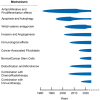Vitamin D and Cancer: An Historical Overview of the Epidemiology and Mechanisms
- PMID: 35406059
- PMCID: PMC9003337
- DOI: 10.3390/nu14071448
Vitamin D and Cancer: An Historical Overview of the Epidemiology and Mechanisms
Abstract
This is a narrative review of the evidence supporting vitamin D's anticancer actions. The first section reviews the findings from ecological studies of cancer with respect to indices of solar radiation, which found a reduced risk of incidence and mortality for approximately 23 types of cancer. Meta-analyses of observational studies reported the inverse correlations of serum 25-hydroxyvitamin D [25(OH)D] with the incidence of 12 types of cancer. Case-control studies with a 25(OH)D concentration measured near the time of cancer diagnosis are stronger than nested case-control and cohort studies as long follow-up times reduce the correlations due to changes in 25(OH)D with time. There is no evidence that undiagnosed cancer reduces 25(OH)D concentrations unless the cancer is at a very advanced stage. Meta-analyses of cancer incidence with respect to dietary intake have had limited success due to the low amount of vitamin D in most diets. An analysis of 25(OH)D-cancer incidence rates suggests that achieving 80 ng/mL vs. 10 ng/mL would reduce cancer incidence rates by 70 ± 10%. Clinical trials have provided limited support for the UVB-vitamin D-cancer hypothesis due to poor design and execution. In recent decades, many experimental studies in cultured cells and animal models have described a wide range of anticancer effects of vitamin D compounds. This paper will review studies showing the inhibition of tumor cell proliferation, dedifferentiation, and invasion together with the sensitization to proapoptotic agents. Moreover, 1,25-(OH)2D3 and other vitamin D receptor agonists modulate the biology of several types of stromal cells such as fibroblasts, endothelial and immune cells in a way that interferes the apparition of metastases. In sum, the available mechanistic data support the global protective action of vitamin D against several important types of cancer.
Keywords: 1,25-(OH)2D3; 25-hydroxyvitamin D; UVB; antitumor action; breast cancer; case-control studies; cohort studies; colorectal cancer; ecological studies; epidemiological studies; randomized controlled trials; vitamin D.
Conflict of interest statement
W.B.G.’s nonprofit organization, Sunlight, Nutrition and Health Research Center, receives funding from Bio-Tech Pharmacal, Inc. (Fayetteville, AR, USA). A.M. has no conflict of interest to declare.
Figures



Similar articles
-
The roles of UVB and vitamin D in reducing risk of cancer incidence and mortality: A review of the epidemiology, clinical trials, and mechanisms.Rev Endocr Metab Disord. 2017 Jun;18(2):167-182. doi: 10.1007/s11154-017-9415-2. Rev Endocr Metab Disord. 2017. PMID: 28213657 Review.
-
Seasonal and geographical variations in lung cancer prognosis in Norway. Does Vitamin D from the sun play a role?Lung Cancer. 2007 Mar;55(3):263-70. doi: 10.1016/j.lungcan.2006.11.013. Epub 2007 Jan 17. Lung Cancer. 2007. PMID: 17207891
-
Review of Recent Advances in Understanding the Role of Vitamin D in Reducing Cancer Risk: Breast, Colorectal, Prostate, and Overall Cancer.Anticancer Res. 2020 Jan;40(1):491-499. doi: 10.21873/anticanres.13977. Anticancer Res. 2020. PMID: 31892604 Review.
-
Folic acid supplementation and malaria susceptibility and severity among people taking antifolate antimalarial drugs in endemic areas.Cochrane Database Syst Rev. 2022 Feb 1;2(2022):CD014217. doi: 10.1002/14651858.CD014217. Cochrane Database Syst Rev. 2022. PMID: 36321557 Free PMC article.
-
Vitamin D Intake, Serum 25-Hydroxyvitamin-D (25(OH)D) Levels, and Cancer Risk: A Comprehensive Meta-Meta-Analysis Including Meta-Analyses of Randomized Controlled Trials and Observational Epidemiological Studies.Nutrients. 2023 Jun 12;15(12):2722. doi: 10.3390/nu15122722. Nutrients. 2023. PMID: 37375626 Free PMC article.
Cited by
-
SIRT1 Mediates the Antagonism of Wnt/β-Catenin Pathway by Vitamin D in Colon Carcinoma Cells.Int J Biol Sci. 2024 Oct 7;20(14):5495-5509. doi: 10.7150/ijbs.95875. eCollection 2024. Int J Biol Sci. 2024. PMID: 39494323 Free PMC article.
-
Unraveling colorectal cancer prevention: The vitamin D - gut flora - immune system nexus.World J Gastrointest Oncol. 2024 Jun 15;16(6):2394-2403. doi: 10.4251/wjgo.v16.i6.2394. World J Gastrointest Oncol. 2024. PMID: 38994172 Free PMC article. Review.
-
Vitamin D Significantly Inhibits Carcinogenesis in the Mogp-TAg Mouse Model of Fallopian Tube Ovarian Cancer.Nutrients. 2024 Sep 30;16(19):3318. doi: 10.3390/nu16193318. Nutrients. 2024. PMID: 39408285 Free PMC article.
-
A Pleiotropic Nuclear Hormone Labelled Hundred Years Ago Vitamin D.Nutrients. 2022 Dec 30;15(1):171. doi: 10.3390/nu15010171. Nutrients. 2022. PMID: 36615828 Free PMC article.
-
Vitamin D induces SIRT1 activation through K610 deacetylation in colon cancer.Elife. 2023 Aug 2;12:RP86913. doi: 10.7554/eLife.86913. Elife. 2023. PMID: 37530744 Free PMC article.
References
-
- Peller S. Carcinogenesis as a means of reducing cancer mortlity. Lancet. 1936;228:552–556. doi: 10.1016/S0140-6736(00)81900-5. - DOI
-
- Peller S., Stephenson C.S. Skin ittittion and cancer in the United States Navy. Am. J. Med. Sci. 1937;194:326–333. doi: 10.1097/00000441-193709000-00004. - DOI
-
- Apperly F.L. The Relation of Solar Radiation to Cancer Mortality in North America. Cancer Res. 1941;1:191–195. - PubMed
-
- Mason T.J., McKay F.W., Hoover R., Blot W.J., Fraumeni J.F., Jr. Atlas of Cancer Mortality for U.S. Counties: 1950–1969. U.S. Department of Health, Education, and Welfare; Washington, DC, USA: 1975.
Publication types
MeSH terms
Substances
Grants and funding
LinkOut - more resources
Full Text Sources
Medical

